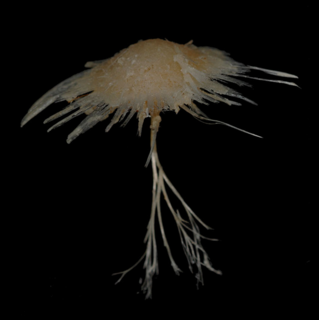
Cladorhiza is a genus of carnivorous sponges, comprising around 40 species found in oceans around the world. Cladorhiza is the type genus of the family Cladorhizidae.

Polymastia is a genus of sea sponges containing about 30 species. These are small to large encrusting or dome-shaped sponges with a smooth surface having many teat-shaped projections (papillae). In areas of strong wave action, this genus does not grow the teat structures, but instead grows in a corrugated form.

Halichondria is a genus of sea sponges belonging to the family Halichondriidae. These are massive, amorphous sponges with clearly separated inner and outer skeletons consisting of bundles of spicules arranged in a seemingly random pattern.

Spongia is a genus of marine sponges in the family Spongiidae, originally described by Carl Linnaeus in 1759, containing more than 60 species. Some species, including Spongia officinalis, are used as cleaning tools, but have mostly been replaced in that use by synthetic or plant material.

Plakinidae is a family of marine sponges. It is composed of seven genera:
Hymeniacidon is a genus of sea sponges in the class Demospongiae. Some members of the genus are known to be mobile, achieving speeds of between 1 and 4 mm per day.
Stelletta is a genus of sea sponges belonging to the family Ancorinidae.

Tethya is a genus of sea sponges belonging to the family Tethyidae. Members of this genus all have a spherical body form and some are known to be able to move at speeds of between 1 and 4 mm per day.

Clathria is a large genus of demosponges in the family Microcionidae.

Haliclona is a genus of demosponges in the family Chalinidae.
Homaxinella is a genus of sea sponges in the family Suberitidae. The type species is Homaxinella balfourensis.

Myxilla is a genus of demosponge belonging to the family Myxillidae. These sponges usually form encrustations on rock surfaces.

Callyspongia is a genus of demosponges in the family Callyspongiidae.

Gelliodes is a genus of sponges in the family Niphatidae.

Clathria (Clathria) is a subgenus of demosponge in the family Microcionidae.

Tedania is a genus of sea sponges in the family Tedaniidae.

Mycale is a genus of demosponge with 240 recognised species in 11 subgenera. It has been a large genus with multiple subdivisions since it was first described in 1867.
Latrunculiidae is a family of sponges belonging to the order Poecilosclerida.

Phorbas is a genus of demosponges belonging to the family Hymedesmiidae.














